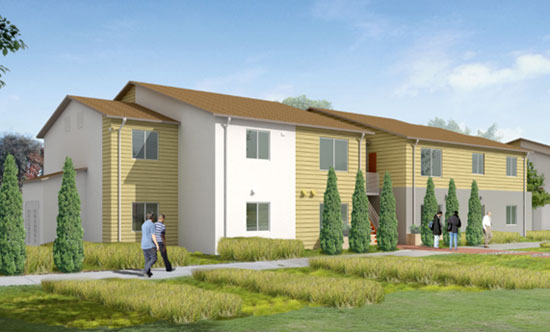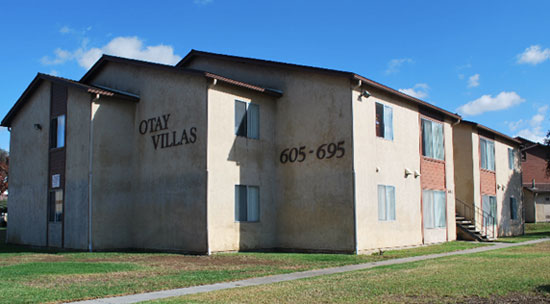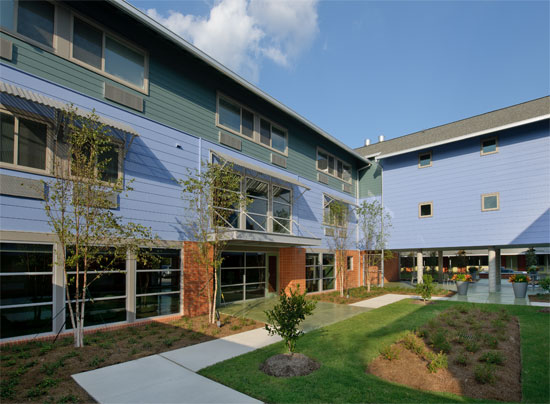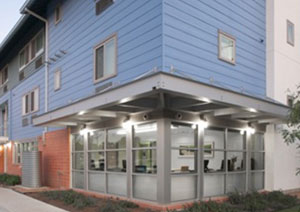Sustainable Extruded Aluminum Trim Profiles Deliver Aesthetics and Durability
Constructed from 75 percent to 100 percent post industrial and post consumer scrap, extruded aluminum trim meets requirements for sustainability and can contribute to LEED® points. It may also be specified for interior or exterior use. Applications include an increasingly wide range of building types wherever fiber cement panels or lap siding is specified. In recent years extruded aluminum trim has begun to replace traditional wood 1x2 and 1x4 trim on single-family homes and is increasingly preferred for multi-family structures.
Extruded aluminum trim products are intended for design aesthetics. They do not include an exterior insulation and finishing system (EIFS) —a type of building exterior wall cladding system that provides exterior walls with an insulated finished surface. Manufacturers usually state if their product does or does not include an insulation system. Since some extruded aluminum trim products on the market incorporate an EIFS, design professionals should note the exact description of each manufacturer's product and its performance expectations. As a general rule extruded aluminum trim products that are not part of an EIFS system are not designed or intended to be used in conjunction with an EIFS or similar system.
Nor do architectural trim profiles form a complete moisture management system. Always a critical feature of construction, a moisture management system is the province of the architect and builder who are responsible for designing and installing a code compliant building envelope. Again, manufacturers usually point out that extruded aluminum trim alone does not include a complete moisture management system, despite the fact that trim is designed with drain dams for vertical runs and shingle fashion for horizontal profiles. Some manufacturers do, however, supply moisture management products that complement their trim line and additionally help meet code requirements (see below).
Design professionals are also advised to consult with the siding manufacturer for "best practice" applications of extruded aluminum trim product in order to ensure color, dimensional and thickness match.
Prefabricated Trim Materials
Extruded aluminum adds durability and longevity to construction that other trim materials such as galvanized steel and polyvinyl chloride (PVC) lack (see sidebar Benefits of Extruded Aluminum).
Galvanized steel
While initially less expensive than extruded aluminum galvanized steel is less durable. The use of bare mill galvanized steel and aluminum flashing in direct contact with most claddings will increase chances of a chemical reaction, causing wear and break down on both products.
Polyvinyl chloride (PVC)
The third-most widely-produced plastic, and the least expensive also has limitations compared with extruded aluminum. One manufacturer of extruded aluminum trim profiles developed and manufactured PVC trim profiles to use with fiber cement siding and soffits, and still does. But through learned experiences and public demand, it began converting its profiles into more durable extruded aluminum. One hundred percent vinyl trim is susceptible to swelling and buckling when exposed to direct sunlight. Moreover, PVC trim with painted dark colors, which is increasingly the choice of architects and developers, may cause the product to warp. This comes about because excess solar heat, especially in hot climates, may be absorbed subjecting the PVC to distortion due to extremes of thermal expansion and contraction. Paint adhesion loss, blistering and peeling may also result.
Characteristics of extruded aluminum trim include:
- Adds a design aesthetic to a wide range of building types.
- Offers multiple profile choices.
- Typically fabricated from custom die-extruded heavy duty 6063 T-5 aluminum alloy with a coating that protects against harsh weather conditions and allows for paint adhesion.
- Typically designed to match color, metal thickness and dimensions of the country's major cementitious siding manufacturer.
- Available in anodized, standard color palette, or ready to paint finishes
- Sustainable material, 75 percent to 100 percent post industrial and post consumer scrap. Can contribute to LEED® points.
- Replaces time-consuming cutting and ripping of fiber cement panels or boards for trim use
- Can be used for interior and exterior weather conditions.
- Highly durable and will long outlast caulk
- Poses no health or physical hazard. {Aluminum trim products are defined as "articles," by the Occupational Safety and Health Administration's (OSHA) and are therefore exempt from the requirement of publishing material safety data sheets.}
| CHARACTERISTICS OF EXTRUDED ALUMINUM |
The most abundant mineral in the earth's crust, aluminum is derived from bauxite, which is mined from the earth. After processing, the resultant alumina undergoes a smelting and alloying process that produces solid logs of cast metal from which extruded aluminum shapes or profiles are made. Most extruded shapes for architectural use are fabricated from AA 6063 an aluminum alloy, with magnesium and silicon as the alloying elements. Type 6063-T5 Aluminum, commonly referred to as the architectural alloy, has a very smooth surface and is the best alloy suited for anodizing applications. The T5 designation indicates it has been artificially aged and moderately heat-treated. Aluminum extrusion is a highly versatile metal-forming process that has a wide array of physical characteristics. These include:
|
| USING ALUMINUM TRIM FOR AFFORDABLE HOUSING RENOVATION | ||||
The San Diego Housing Commission wanted to renovate Picador Boulevard Apartments, an affordable housing complex in San Diego, CA consisting of 78 units in 11 buildings that was originally built in 1978. Sillman Wright Architects selected a combination of fiber cement panels and stucco to create a much needed face lift for the outdated apartments. "We really wanted to transform these buildings and create a sense of home for the residents," says Brett Tullis AIA, LEED AP BD + C. "We wanted a cleaner look for the buildings that would be durable and low maintenance to contrast the existing chunky wood trim and yellow stucco that was so typical of that era. We selected the fiber cement panels with the aluminum trim because it will resist abuse and perform and is a great looking, cost effective alternative to the traditional fiber cement panel detailing. It gave us the sharper more modern detailing we wanted without additional material or labor costs."
|
| MANY USES OF ALUMINUM TRIM FOR NEW HOPE HOUSING, INC. | ||||
The new 2424 Sakowitz affordable housing facility in Houston, Texas, developed by New Hope Housing, Inc, and designed by Val Glitsch, FAIA, LEED® AP, Houston, is three-story wood construction on a concrete foundation. The exterior is a mix of brick, fiber cement panels and lap siding. Pre-manufactured aluminum trim was placed above, below and between the different types of fiber cement siding; above windows and doors and below the siding over brick. It also was used for both inside and outside corners and where panels meet the siding boards. "The alternative to pre-manufactured trim? Wood trim gives a very different aesthetic. It is bulkier and, for water infiltration concerns, can only be used for vertical joints," says Glitsch. "We could have had a metal shop make up the trim pieces, but that's not always a good way to get a quality, consistent, cost-effective product. And the heavier-weight 'extreme trim' we used makes it easier to install the product properly." |













